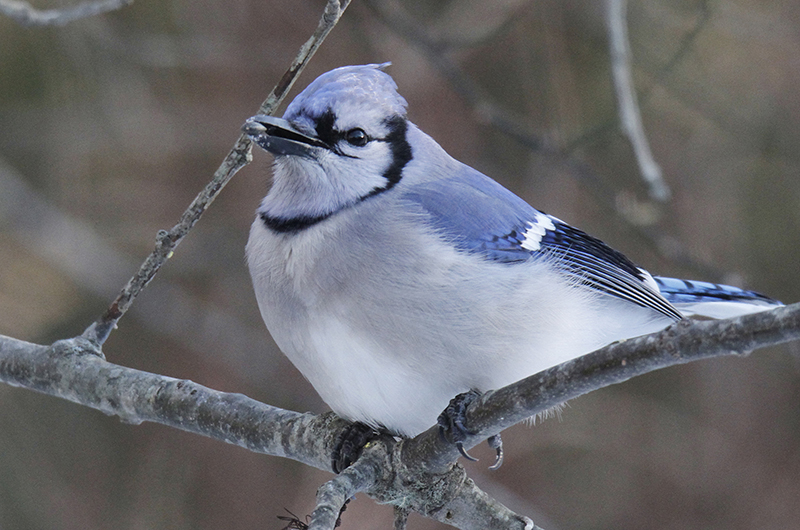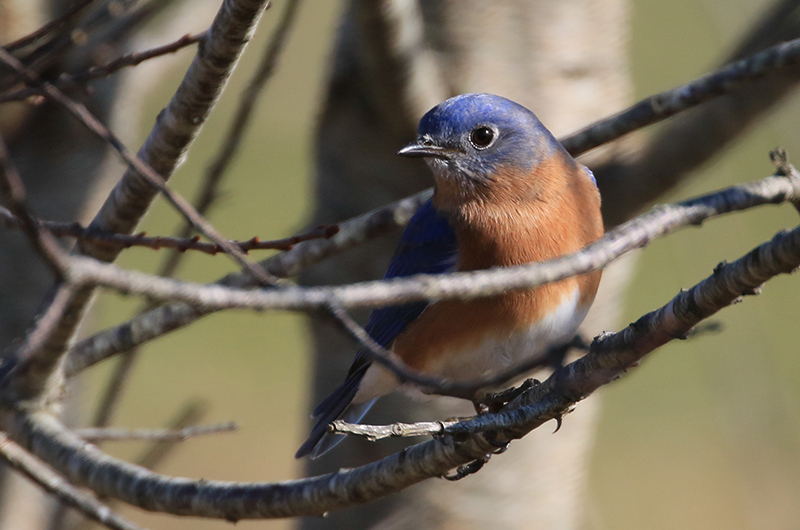So you think birds get along together at your feeders? Not so fast. There is a daily struggle for dominance in your backyard. Evidence of aggression may be as little as a bird changing its posture in the presence of another, flying away, waiting for another bird to leave the feeder, tilting its bill straight up into the air, or even seeming to make itself appear smaller than it actually is.
Recently, a study from the Cornell Laboratory of Ornithology used interactions between species to calculate a fight score for our common feeder birds. Ranked from more aggressive to less aggressive were red-bellied woodpecker, blue jay, northern cardinal, white-breasted nuthatch, tufted titmouse, dark-eyed junco, and, least aggressive of all, black-capped chickadee.
Does this pecking order match your observations?
Bird Sightings
Avian courtship activity increases as day length and temperature increases. Recent sightings of courting American woodcocks provide some evidence. Bob Shriber reports one calling and displaying in the meadow near the Gay Head Cliffs on Feb. 23, and Francesca Zeta reports hearing them in the state forest on Feb. 28.
The nasal peenting and the varied twittering sounds males make on their courtship flights are impressive and worth the effort it takes to find them. The disc golf course in the state forest at dusk is perhaps the most reliable time and place to hear them.
Migrating red-winged blackbirds are becoming more prevalent. On Feb. 28, Matt Pelikan spotted a flock of 20 singing from the tree tops in his Oak Bluffs neighborhood, and a single grackle was in his yard. Ned Casey also had a few red-wings visit his yard, as did Gus Ben David. And Tony Lima has been hearing red-wings at Farm Pond for the last week of February.
At my house this week, cardinals have joined the rising numbers of singing birds in the yard. And on Feb. 28, at least two eastern bluebirds were singing at Cedar Tree Neck. This is evidence of increasing courtship activity. And to infringe on the turf of the neighboring gardening column, I also found numerous leaves of Japanese honeysuckle near Cedar Tree Neck that day. While it was nice to see green leaves, such early leaf emergence and the resulting photosynthesis is one of the reasons why it is such a dominant and invasive species. Nevertheless, evidence of the approaching spring.
In other birding news, I spotted a greater yellowlegs in the West Basin salt marsh on Feb. 24, and Allan Keith spotted it again the next day. This is likely a winter resident as it may well be the same bird that Bob Shriber found in Aquinnah on Feb. 7. I could only find two other February records of this species in New England this year. An historical reference to yellowlegs sightings at this time of year comes from John Nelson, who commented that hunters in the 1800s referred to “winter yellowlegs.”
Also on Feb. 24, in the ocean by the Gay Head Cliffs, I spotted two dovekies and three razorbills — quite the collection of small black and white seabirds. It has been a while since I spotted two species of alcids near each other.
In other waterbird sightings, Hans Goeckel spotted the lone snow goose that has been hanging out with the larger Canada geese at Katama on Feb. 24 and again on Feb. 28. My niece Taylor Culbert and I spotted the bird on Feb. 26 at nearby Muskoday Farm. On Feb. 25, Allan Keith visited Squibnocket and found 23 lesser scaup, harlequin ducks, common eiders, black scoters, common goldeneye, two pintail, and four pairs of gadwall. Lanny McDowell spotted a pintail at Black Point Pond on Feb. 26, and Lisa Maxfield found a gadwall on Brush Pond on Feb. 27.
Noah Henkenius spotted both black-bellied plovers and dunlin on Sarson’s Island on Feb. 28. And Gus Ben David reports that an adult great blue heron has been visiting his ponds over the past week or so.
On the bald eagle front, Mariah Ben David spotted two of them at the Oak Bluffs pumping station on Feb. 25. The next day, Kenneth Harris saw one soaring high over Chappy. Then, on both Feb. 27 and Feb. 28, Matt Pelikan spotted one flying over his house.
On the corvid (crow family) front, David and son John Stanwood were in their yard on March 1 when they “heard a low course call from overhead. We looked up to see a raven flying over. It was my son’s first time seeing one and he was impressed by the different look, particularly of the tail as well as its size and sounds.”
Also of interest, Lanny McDowell took a series of photographs of an American crow playing with a nip bottle on East Chop on Feb. 25. And, last but not least, Kate Bagnati has been hearing bluejays (yes, they are corvids) sounding like a kid blowing on a recorder. You cannot invent this stuff.
Please email your sightings to birds@mvgazette.com.
Robert Culbert is an ecological consultant with Nature Watch LLC living in Vineyard Haven.










Comments
Comment policy »